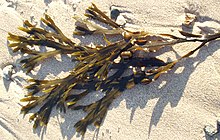Lulworthiaceae
| Lulworthiaceae | |
|---|---|
| Scientific classification | |
| Kingdom: | |
| Division: | |
| Class: | |
| Order: | |
| Family: | Lulworthiaceae Kohlm.
|
| Type genus | |
| Lulworthia G.K. Sutherl.
| |
The Lulworthiaceae are a family of marine fungi in the Ascomycota, class Sordariomycetes.[1] Species in the family have a widespread distribution in both temperate and tropical oceans, and are typically found growing on submerged wood or on seaweed.[2] In 2000, Molecular analysis of several species of Lulworthia and Lindra led to the reassignment of their parent genera to the new order Lulworthiales in addition to the new family Lulworthiaceae.[3] In 2020, a large fungi study added more genera to the family.[4]
History and taxonomy
[edit]The type genus Lulworthia was originally described in 1916 by George Kenneth Sutherland to contain the species Lulworthia fucicola, a fungus found on the seaweed commonly known as the bladder wrack at Lulworth on the coast of Dorset, UK.[5] The fungus has since been collected several times from submerged wood, but never again from the original algal host; it was subsequently reported that specimens found on wood were morphologically different from those originally described growing on algae.[6] Since the original specimens had deteriorated beyond use, a holotype was designated, using submerged-wood specimens found in Chile in 1984.[7]
The genus Rostrupiella was created in 2007 to contain the species Rostrupiella danica, a Lulworthia-like species collected on driftwood found along the Danish coast and from the northwestern coast of the US.[8]

Genera
[edit]As accepted by Wijayawardene et al. 2020 (with amount of species per genus);[4]
- Cumulospora I. Schmidt (2)
- Halazoon Abdel-Aziz, Abdel-Wahab & Nagah. (2)
- Haloguignardia A. Cribb & J. Cribb (1)
- Hydea K.L. Pang & E.B.G Jones (1)
- Kohlmeyeriella E.B.G. Jones, R.G. Johnson & S.T. Moss (2)
- Lindra I. Wilson (5)
- Lulwoana Kohlm., Volkm.-Kohlm., J. Campb., Spatafora & Gräfenhan (1)
- Lulwoidea Kohlm., Volkm.-Kohlm., J. Campb., Spatafora & Gräfenhan (1)
- Lulworthia G.K. Sutherl (32)
- Matsusporium E.B.G. Jones & K.L. Pang (1)
- Moleospora Abdel-Wahab, Abdel-Aziz & Nagah (1)
- Moromyces Abdel-Wahab, K.L. Pang, Nagah., Abdel-Aziz & E.B.G. Jones (1)
- Orbimyces Linder (1)
- Paralulworthia A. Poli, E. Bovio, L. Ranieri, G.C. Varese & V. Prigione (3)
- Rostrupiella Jørg Koch, K.L. Pang & E.B.G. Jones. (1)
- Sammeyersia S.Y. Guo, E.B.G. Jones & K.L. Pang (1)
Description
[edit]The ascomata, roughly spherical to cylindrical in shape, may be either embedded in or on the material to which the fruit body is attached. Atop the ascomata is a small rounded process with an opening (an ostiole) through which ascospores may be released. The brown- to black-colored ascomata can be either leathery (coriaceous) or dark-colored and readily broken (carbonaceous). The internal structure of the ascomata, the centrum, is at first filled with a transparent pseudoparenchyma (a type of tissue made of hyphae that are twisted and matted together) dissolves upon reaching maturity. The Lulworthiaceae have ascospores that are both filamentous, and transparent.[3]
References
[edit]- ^ Lumbsch TH, Huhndorf SM (December 2007). "Outline of Ascomycota – 2007". Myconet. 13. Chicago, US: The Field Museum, Department of Botany: 1–58. Archived from the original on 18 March 2009.
- ^ Cannon PF, Kirk PM (2007). Fungal Families of the World. Wallingford: CABI. pp. 194–95. ISBN 978-0-85199-827-5.
- ^ a b Kohlmeyer J, Spatafora JW, Volkmann-Kohlmeyer B (2000). "Lulworthiales, a new order of marine Ascomycota". Mycologia. 92 (3): 453–58. doi:10.2307/3761504. JSTOR 3761504.
- ^ a b Wijayawardene, Nalin; Hyde, Kevin; Al-Ani, Laith Khalil Tawfeeq; Somayeh, Dolatabadi; Stadler, Marc; Haelewaters, Danny; et al. (2020). "Outline of Fungi and fungus-like taxa". Mycosphere. 11: 1060–1456. doi:10.5943/mycosphere/11/1/8. hdl:10481/61998.
- ^ Sutherland GK. (1916). "Additional notes on marine pyrenomycetes". Transactions of the British Mycological Society. 5: 257–63. doi:10.1016/S0007-1536(14)80029-6.
- ^ Kholmeyer J, Volkmann-Kohlmeyer B (2000). "Illustrated key to the filamentous higher marine fungi". Botanica Marina. 34: 1–61. doi:10.1515/botm.1991.34.1.1. S2CID 83745842.
- ^ Campbell J. (2005). "Neotypification of Lulworthia fucicola". Mycologia. 97 (2): 549–51. doi:10.3852/mycologia.97.2.549. PMID 16396361.
- ^ Koch J, Pang KL, Jones EB (2007). "Rostrupiella danica gen. et sp nov., a Lulworthia-like marine lignicolous species from Denmark and the USA". Botanica Marina. 50 (5–6): 294–301. doi:10.1515/BOT.2007.034. S2CID 86133897.
